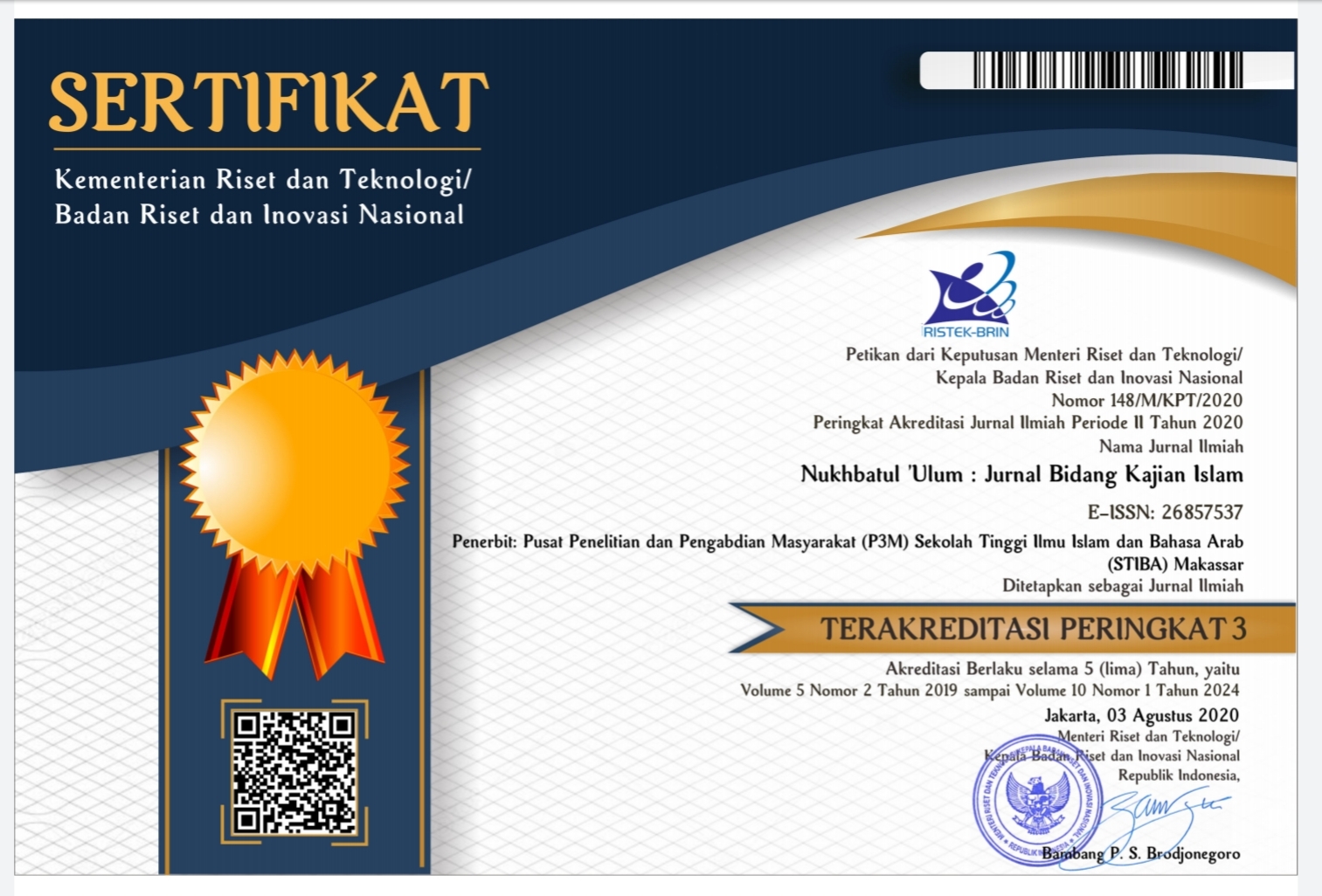Tradisi Te'nea dalam Perspektif Hukum Islam (Studi Kasus di Desa Majannang)
Te'nea Tradition in the View of Islamic Law Perspective (Case Study in Majannang Village)
DOI:
https://doi.org/10.36701/nukhbah.v6i1.102Keywords:
Culture, Te'nea Tradition, Majannang, Islam, FaithAbstract
The purpose of this research was to identify the description of te'nea tradition, to recognize the driving force behind the shift in the meaning of te’nea tradition, and to explain the view of Islamic law regarding te’nea tradition in Majannang Village, Parigi District, Gowa Regency. The research method employed field research studies with a case study format through sociological and normative approaches.. The results showed that te'nea tradition was initially conducted merely with the purpose of kinship and eating together with relatives in an effort to commemorate the ancestors of the Pajaiyya extended family. The shift of the meaning of te'nea tradition occurred due to healing phenomenon of a broken leg sufferer in Bungung Toa where the ritual of te'nea took place. The shift of the tradition of te'nea is very fatal because it is suspected to contain shirk which has implications for the haram of this tradition in the perspective of Islamic Law, but if the element of shirk can be eliminated then this tradition will be in line with the teachings of friendship which is mustahab (recommended).
Downloads
References
Ahmad bin Syekh Muhammad al-Rizqa, Syarhu al-Qawa>’id al-Fiqhiyyah (Dimasq: Dar al-Qalam 1989).
Asma bin Abdullah al-Musa, Al-‘Urfu Hujjiyatuhu wa Atsaruhu al-Fiqhiyah (Riyad: Al-Majjallah al-Arabiyah Li al-Dirasat Amaniyah wa al-Tadrib t.th).
Bauto, L. M. (2014). Perspektif agama dan kebudayaan dalam kehidupan masyarakat indonesia (Suatu tinjauan sosiologi agama). Jurnal Pendidikan Ilmu Sosial, 23(2), 11-25.
Burga, M. A. (2019). Hakikat Manusia Sebagai Makhluk Pedagogik. Al-Musannif, 1(1), 19-31.
Karim, A. (2017). Makna ritual kematian dalam tradisi Islam Jawa. Sabda: Jurnal Kajian Kebudayaan, 12(2), 161-171.
Kaukab Ubaid, Fiqh al-Ibada>t 'ala al-Mazhab al-Ma>likiyah (Dimasq: Matba' al-Insya' 1986), h.11
Lestari, G. (2016). Bhinnekha Tunggal Ika: Khasanah Multikultural Indonesia Di Tengah Kehidupan SARA. Jurnal Pendidikan Pancasila dan Kewarganegaraan, 28(1).
Al-Majid, Al-Qur’an Terjemah dan Tajwid Warna (Jakarta Pusat: Beras 2014).
Marinsah, S. A., Hamdan, M. N., Ariffin, M. F. M., & Ramli, M. A. (2016). Amalan tradisi masyarakat Bajau di Semporna Sabah: kajian menurut hukum Islam. Perspektif: Jurnal Sains Sosial dan Kemanusiaan, 8(2), 135-149.
Muhammad bin Isma’i>l al-Bukha>ri, S}ahi>h al-Bukha>ri, Vol 8 (Dimasq: Dar Tuq al-Najah 1422 H).
Mujib, M. M. (2016). Fenomena Tradisi Ziarah Lokal dalam Masyarakat Jawa: Kontestasi Kesalehan, Identitas Keagamaan dan Komersial. IBDA: Jurnal Kajian Islam dan Budaya, 14(2), 204-224.
Muslim bin al_Hajja>j al-Naisaburi, S{ahi>h Muslim (Bairut: Dar Ihya Turas al-Araby t.th).
Muslim bin al_Hajja>j al-Naisaburi, S{ahih Muslim, Vol 3. h.1567.
Muslim bin al_Hajja>j al-Naisaburi, S}ahi>h Muslim, Vol 4. h.198.1
Nurdin, A. (2016). Integrasi Agama dan Budaya: Kajian Tentang Tradisi Maulod dalam Masyarakat Aceh. EL HARAKAH (TERAKREDITASI), 18(1), 45-62.
Wagianto, R. (2017). Tradisi Kawin Colong Pada Masyarakat Osing Banyuwangi Perspektif Sosiologi Hukum Islam. Al-Ahwal: Jurnal Hukum Keluarga Islam, 10(1), 61-84.


















